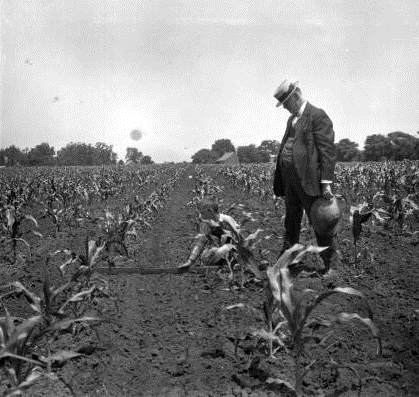
4-H Corn Club youth showing a County Extension Agent that he had properly cultivated his corn. 1919. Photo Credit: State Archives of Florida, Florida Memory, http://floridamemory.com/items/show/36694
Truly amazing things can happen in the span of 100 years. In this day and age, however, where everything is expected to be “bigger-better-faster,” accomplishments over a 100 year time-span are often overlooked as only a “drop in the bucket” as they say. Let’s slow down a minute, though, and reflect on the accomplishments of the 100 Year Anniversary of the Smith-Lever Act of 1914 and UF/IFAS Extension.
In 2014, America celebrates the 100th Anniversary of the Extension Service. The Smith-Lever Act of 1914 established the Cooperative Extension Service, a state-by-state national network of land-grant, public universities, whose educators extend research-based knowledge to the people.
SEC. 1. (7 U.S.C. 341)In order to aid in diffusing among the people of the United States useful and practical information on subjects relating to agriculture, uses of solar energy with respect to agriculture, home economics, and rural energy, and to encourage the application of the same, there may be continued or inaugurated in connection with the college of colleges in each State, Territory, or possession,……
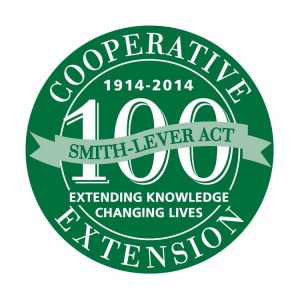 For 100 years, the Smith-Lever Act has stimulated innovative research and vital educational programs for adults and youth through progressive information delivery systems that have improved lives and shaped a nation. The Cooperative Extension Service, allows us all to benefit from the knowledge of our nation’s land-grant universities.
For 100 years, the Smith-Lever Act has stimulated innovative research and vital educational programs for adults and youth through progressive information delivery systems that have improved lives and shaped a nation. The Cooperative Extension Service, allows us all to benefit from the knowledge of our nation’s land-grant universities.
UF/IFAS Extension has helped millions of Floridians by tapping the latest information from the research engines of both the University of Florida and Florida A&M University. If you’ve learned how to produce crops or raise livestock more efficiently, if you’ve learned how to choose healthier foods, conserve and protect drinking water and natural resources, save money, grow your own vegetables, if you’ve been to a 4-H camp, or received help from a Master Gardener, chances are you’ve been helped by Extension!
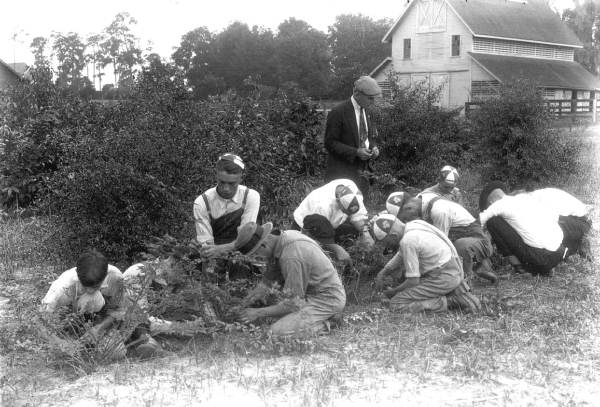
Teaching 4-H youth the science of grafting and budding. 1900s. Photo Credit: State Archives of Florida, Florida Memory, http://floridamemory.com/items/show/63198
The Extension Agents, staff, and volunteers of the UF/IFAS Extension in Northwest Florida are proud of our accomplishments as we reflect on this 100th anniversary. We are proud of our agricultural roots and we look to the future. We are dedicated to finding solutions to the challenges we will face over the next 100 years and sharing them to make life healthier, happier, and more prosperous for you. Join us as we celebrate the past, present, and future of extending knowledge and changing lives.
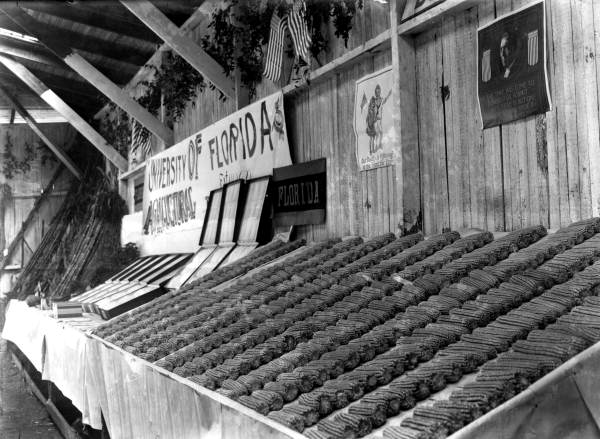
Corn Club exhibit at the Jackson County fair, 1917. Photo Credit: State Archives of Florida, Florida Memory, http://floridamemory.com/items/show/35976
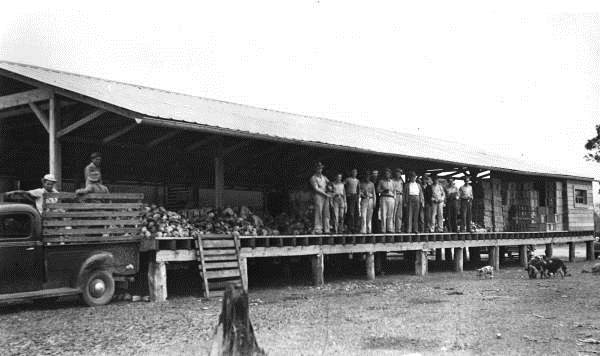
Florida Farmers with cabbage at the Marianna and Blountstown train depot at Blountstown or Altha, 1950s. Photo Credit: State Archives of Florida, Florida Memory, Railroad, http://floridamemory.com/items/show/68
Below is a Time-Line of UF/IFAS Extension and more details about the Smith-Lever Act:
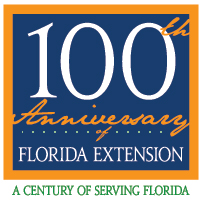 History of UF/IFAS Extension:
History of UF/IFAS Extension:
1862 President Abraham Lincoln signs the Morrill Act establishing the land-grant university system.
1884 Florida College of Agriculture (later UF), Florida’s first land-grant university, established in Lake City.
1887 Hatch Act establishes Agricultural Experiment Stations tied to land-grant universities for the purposes of scientific research.
1887 State Normal College for Colored Students (later Florida A&M) established in Tallahassee.
1890 2nd Morrill Act establishes African-American land-grant universities.
1899 First “Farmers Institute” established in Florida to provide demonstrations in modern agricultural techniques.
1902 Seaman Knapp appointed by USDA to help Texas cotton farmers combat boll weevil infestation.
1906 Florida College of Agriculture moved to Gainesville, Florida to become part of the new University of Florida.
1908 Agnes Ellen Harris conducts a canning demonstration in Ocala, eventually leading to the creation of Extension Home Demonstration.
1909 J. J. Vernon, University of Florida Dean of Agriculture, organized the first “corn” clubs for boys (a precursor to 4-H clubs) in Alachua, Bradford and Marion counties.
1911 “Better Farming Special” train tours Florida, giving demonstrations in modern techniques of farming, livestock and domestic arts.
1912 First “tomato” clubs for girls (a precursor to 4-H clubs) organized through schools in Florida.
1914 U.S. Congress passes Smith-Lever Act, establishing national Agricultural Extension Service.
1915 Florida Legislature accepts the Smith-Lever Act; P.H. Rolfs becomes first director of Extension, as well as Florida Agricultural Experiment Station.
1915 Segregated Extension work with African-American Floridians begins when more than 1,200 youth enroll in farm and home makers’ clubs organized through Florida A&M University.
1915 Extension agents begin program to inoculate hogs against hog cholera epidemic.
1916 Florida Extension Homemaker Council Established to promote new scientific information through practical demonstrations.
1917 Agricultural News Service, Florida Extension’s first mass media effort, publishes first issue.
1917 The Citrus Experiment Station, the first permanent branch research station in the state, opens in Lake Alfred.
1917 U.S. entry into World War I. Extension called on to help increase Florida’s food production and preservation.
1919 State Girls’ 4-H Council formed.
1921 North Florida Experiment Station Established at Quincy.
1922 First school lunches in Florida’s rural schools organized by extension home demonstration agents in Orange and Osceola counties.
1922 First Farmers Week established at University of Florida.
1922 Capper Volstead Act gave legal status to farm co-ops.
1924 4-H name and clover emblem patented.
1924 Everglades Experiment Station established at Belle Glade.
1925 Purnell Act provided funds for economic and social research by agricultural experiment stations.
1926 Camp Timpoochee becomes the first permanent 4-H camp in Florida.
1928 Capper-Ketcham Act provides for the further development of agricultural extension work at the 1862 land-grant colleges.
1928 Florida Extension Service begins radio broadcasts.
1929 Great Depression begins. Florida Extension Home Demonstration agents respond by giving courses in canning, clothing repair and selling home-produced products.
1934 4-H Camp McQuarrie acquired.
1935 Bankhead-Jones Act adds to annual appropriations for land-grant institutions and Extension programs.
1937 4-H Camp Cherry Lake opens in North Florida.
1937 Range Cattle Experiment Station established at Ona.
1939 Florida Legislature created the School of Forestry at the University of Florida.
1940 Extension begins work with USDA’s Rural Electrification Administration to bring electrical power to Florida’s farms and ranches.
1940s Extension service and USDA eradicate cattle tick infestation in Florida.
1943 West Florida Experiment Station established at Jay.
1945 Bankhead-Flanagan Act furthers the development of cooperative extension work in agriculture and home economics.
1948 Indian River Field Laboratory established at Fort Pierce.
1949 4-H Camp Doe Lake in the Ocala National Forest established for African-American 4-H’ers.
1950 Suwannee Valley Experiment Station established at Live Oak.
1950 4-H Camp Cloverleaf opens.
1952 First television program produced by Extension airs on Jacksonville’s WMBR-TV (now WJXT)
1952 4-H grows to 1,294 clubs in Florida, reaching 110,113 youth.
1953 Smith-Lever Act Amendment simplified and consolidated ten separate laws relating to Extension. Established new funding procedures based on rural/urban population formula and amounts.
1955 Florida 4-H club established with Seminole Tribe in South Florida.
1955 Smith-Lever Amendment authorizes work with disadvantaged farms and farm families and funds for Extension outside the traditional funding “formula.”
1958 Extension Plant Disease Clinic established to diagnose diseases of crops, ornamentals and trees, and to suggest control measures.
1959 Screwworm eradicated in Florida with help from Extension.
1961 Food Science Extension Program initiated, offering short courses on food additives, water quality, and flavor chemistry research.
1964 Institute of Food and Agricultural Sciences (IFAS) established as the unifying administrative umbrella for UF’s programs in agriculture, forestry and related programs.
1964 Civil Rights Act of 1964 outlaws most forms of discrimination by race, religion and gender.
1964 State Extension Home Demonstration headquarters move from Tallahassee to Gainesville.
1964 4-H becomes co-educational.
1965 Florida Extension programs racially integrated.
1966 African-American youth attend the statewide 4-H club conference for the first time.
1966 4-H begins transition out of school-based programs into volunteer-led community project clubs.
1966 Sea Grant established through the National Sea Grant College and Program Act.
1968 Special Help for Agricultural Research and Education (SHARE) Council established to raise funds for agricultural research and education.
1969 USDA and Extension initiates Florida’s Expanded Food Education Program (EFNEP) to educate limited-income families on diet and nutritional issues.
1970 Florida declared free of hog cholera.
1970 Florida Agricultural Extension Service changes its name to Florida Cooperative Extension Service in order to reflect the expansion of Extension’s mission.
1970 State Extension Management and Information System computerizes Extension reporting for the first time.
1971 Florida Sea Grant established as a joint effort between the National Sea Grant College and Florida Cooperative Extension Service.
1973 Florida 4-H Foundation chartered.
1975 Extension Indian work merged with other Extension work.
1975 Names of all experiment stations and field labs changes to agricultural research and education centers (RECs).
1979 Extension’s Florida Master Gardener Program established to offer intense home horticulture training to individuals who then volunteer in their communities.
1984 Over 10,400 adult and teen volunteers work with 84,000 Florida 4-H youth.
1987 Florida Lakewatch, a volunteer program to monitor water quality, takes first water sample.
1990 Farm Bill authorizes the Extension Indian Reservation Program.
1994 National Agricultural Research, Extension and Teaching Act confers land-grant status on 29 Native American colleges.
1994 Agricultural Reorganization Act establishes the Cooperative State Research, Education, and Extension Service (CSREES) to coordinate USDA and state cooperative agricultural research, extension, and education programs.
1995 Family Nutrition Program (FNP) established for food stamp recipients in 35 Florida counties.
1995 Extension’s first comprehensive website, the Florida Agricultural Information Retrieval System (FAIRS) goes online.
1998 Florida Automated Weather Network (FAWN) established to collect and share weather data with Florida’s growers.
1998 The Extension Data Information Source (EDIS) established as the online source for UF/IFAS Extension’s research-based, up-to-date educational resources.
1998 Fishing For Success, a program that uses fishing and other activities to introduce children to aquatic environmental sciences, begins at UF/IFAS’ School of Forest Resources and Conservation.
2003 Distance Diagnostic Information System (DDIS) enables homeowners and commercial growers to treat plant and insect problems over the internet.
2004 “Family Album Radio” program debuts, covering such topics as nutrition, family relationships and communication.
2005 Extension’s Program for Resource Efficient Communities established, begins work with developers on sustainable community planning in Harmony, FL.
2005 4-H’s Operation: Military Kids partners with U.S. Armed Forces to help families adjust to military deployment.
2006 “Gardening in a Minute,” a UF/IFAS Extension radio series, begins broadcast.
2008 Florida Friendly Landscaping program established to help Floridians create beautiful, sustainable landscapes using native plants that need little irrigation.
2009 On its 100th anniversary, Florida 4-H membership reaches 234,000 youth, with help from 10,000 volunteers.
2010 Deepwater Horizon oil spill in Gulf of Mexico; Florida Sea Grant and UF/IFAS Extension mobilize to test safety of gulf’s seafood.
2014 UF/IFAS Extension celebrates 100th anniversary!
More about the Smith-Lever Act:
Established in 1914, Cooperative Extension was designed as a partnership of the U.S. Department of Agriculture and the land-grant universities, which were authorized by the Federal Morrill Acts of 1862 and 1890. Legislation in the various States has enabled local governments or organized groups in the Nation’s counties to become a third legal partner in this education endeavor. The congressional charge to Cooperative Extension through the Smith-Lever Act of 1914 is far ranging. Today, this educational system includes professionals in each of America’s 1862 land-grant universities (in the 50 States, Puerto Rico, the Virgin Islands, Guam, Northern Marianas, American Samoa, Micronesia, and the District of Columbia) and in the Tuskegee University and sixteen 1890 land-grant universities. The provisions of the Act, in effect as of November 13, 2002, are shown below.
[As Amended Through Public Law 107–293, Nov. 13, 2002]
Act of May 8, 1914, ch. 79, 38 Stat. 372, 7 U.S.C. 341 et seq.
Chap. 79.—AN ACT TO PROVIDE FOR COOPERATIVE AGRICULTURAL EXTENSION WORK BETWEEN THE AGRICULTURAL COLLEGES IN THE SEVERAL STATES RECEIVING THE BENEFITS OF AN ACT OF CONGRESS APPROVED JULY SECOND, EIGHTEEN HUNDRED AND SIXTY-TWO, AND OF ACTS SUPPLEMENTARY THERETO, AND THE UNITED STATES DEPARTMENT OF AGRICULTURE
SEC. 1. (7 U.S.C. 341)In order to aid in diffusing among the people of the United States useful and practical information on subjects relating to agriculture, uses of solar energy with respect to agriculture, home economics, and rural energy, and to encourage the application of the same, there may be continued or inaugurated in connection with the college of colleges in each State, Territory, or possession, now receiving, or which may hereafter receive, the benefits of the Act of Congress approved July second, eighteen hundred and sixty-two, entitled ‘‘An Act donating public lands to the several States and Territories which may provide colleges for the benefit of agriculture and the mechanic arts’’ (Twelfth Statutes at Large, page five hundred and three) and of the Act of Congress approved August thirtieth, eighteen hundred and ninety (Twentysixth Statutes at Large, page four hundred and seventeen and chapter eight hundred and forty-one), agricultural extension work which shall be carried on in cooperation with the United States Department of Agriculture: Provided, That in any State, Territory, or possession in which two or more such colleges have been or hereafter may be established, the appropriations hereinafter made to such State, Territory, or possession shall be administered by such college or colleges as the legislature of such State, Territory, or possession may direct. For the purposes of this Act, the term ‘‘solar energy’’ means energy derived from sources (other than fossil fuels) and technologies included in the Federal Non-Nuclear Energy Research and Development Act of 1974, as amended.
SEC. 2. (7 U.S.C. 342)Cooperative agricultural extension work shall consist of the development of practical applications of research knowledge and giving of instruction and practical demonstrations of existing or improved practices or technologies in agriculture, uses of solar energy with respect to agriculture, home economics, and rural energy, and subjects relating thereto to persons not attending or resident in said colleges in the several communities, and imparting information on said subjects through demonstrations, publications, and otherwise and for the necessary printing and distribution of information in connection with the foregoing; and this work shall be carried on in such manner as may be mutually agreed upon by the Secretary of Agriculture and the State agricultural college or colleges or Territory or possession receiving the benefits of this Act.
- Maintaining Dissolved Oxygen Levels in Your Pond to Reduce Fish Kills - September 21, 2018
- The Bumble Bee – One of Florida’s Vital Pollinators - September 14, 2018
- 2017-2018 Bee Informed Partnership’s National Bee Colony Loss Report - July 13, 2018
